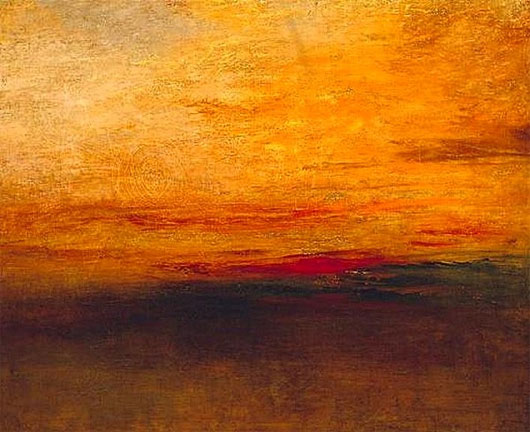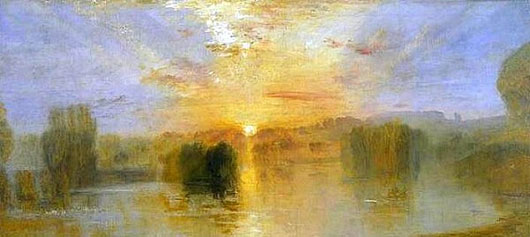Climate change through the famous sunset picture
Only by analyzing the paintings of the sunset, scientists can point out the status of climate change on Earth .
Climate change is a new topic but never old, simple because so far, although more or less, people are still suffering from its consequences every day.
Many people still mistakenly believe that this is a new issue raised not long ago but in reality it is not. Scientists have shown that global climate change has been mentioned for a long time, quietly and delicately in famous paintings .
For those who love British painting, surely we are no stranger to the name of JMW Turner - a famous painter with paintings like "The Lake, Petworth: Sunset, Fighting Bucks".
However, hidden behind these famous paintings is the perception of climate change through the eyes of an artist. Physics professor Christos Zerefos, of the Athens Academy and colleagues conducted a study, analyzing hundreds of paintings drawn in the period 1500-2000 to draw conclusions.

A picture depicting Turner's sunset painted around the 1830s

And another picture of Turner paints the sunset at a time when there is no major volcanic eruption in the world
The work of the expert team led by Professor Zerefos focuses primarily on the impact that volcanic eruptions cause on the Earth's atmosphere. For example, in 1815, the Tambora volcano was located on Indonesia's Sumbawa island, which started again, causing one of the biggest eruptions in human history.
This tragedy killed 10,000 people directly and about 60,000 other victims because of hunger and disease during the 'volcanic winter' (ash covered the atmosphere so that the Sun could not shine) then. In addition, this event is the culprit causing the global temperature drop and lead to the failure of the crop in the next few years.

For the atmosphere, volcanic eruptions will release a large amount of ash floating in the air, preventing the sun from shining on the ground.The time of sunset, the color of the sky will also change significantly compared to normal because the light is refracted when passing through the dust particles.
In other words, it is also the time to observe most changes in the air with the naked eye . Therefore, by analyzing ancient sunset paintings, it is possible to find and calculate the rate of climate change from the Middle Ages to the present.

Analyzing John Crome's "A Windmill near Norwich" picture, the author saw the impact of the eruption at Mount Tambora at the time of drawing it.
Specifically, the period 1500-2000 recorded more than 50 major volcanic eruptions on a global scale, significantly affecting the atmosphere and the process of climate change later. Famous artists like Turner painted many sunset paintings during this period.
Through analysis, understanding them, experts assert that it can be clearly seen. The evidence is that regardless of the artist's character or trend of painting, most paintings of the sunset when volcanic eruptions use the same ratio of green and red. This research has now been published in the Journal of Atmospheric and Physical Chemistry, drawing much attention from public opinion.

To verify the accuracy of the judgment, the team asked artist P.Tetsis to draw two pictures of the same scene: sunset on Hydra Island at two times, before and after a cloud of dust from The Sahara flies over this region.
The results of the optical analysis of the ratio of 2 colors in green and red also showed similar results as the initial judgment of experts.

Two paintings by artist P.Tetsis about the same scene
Professor Zerefos concludes: 'We want to provide a way to harness completely new information about the environment and the atmosphere in centuries ago when scientific tools were not yet popular. We can understand how the ash from volcanoes affects our atmosphere and the amount of information that will help significantly improve our ability to forecast climate change in the future. '
- The grim picture of climate change is spreading wildly on the Internet
- Sunset color lavender in Nanjing
- This is how Dubai copes with climate change
- These 9 famous landmarks are about to disappear forever, all because ...
- What is Climate Change?
- Marching for climate change around the world
- The terrifying change of the Earth due to climate change
- SimCLIM helps build climate change scenarios
- Climate change is happening faster than expected
- 4 shocking findings on climate change
- Too many animals and plants disappear due to climate change
- How is climate change damaging our health?
 'Fine laughs' - Scary and painful torture in ancient times
'Fine laughs' - Scary and painful torture in ancient times The sequence of numbers 142857 of the Egyptian pyramids is known as the strangest number in the world - Why?
The sequence of numbers 142857 of the Egyptian pyramids is known as the strangest number in the world - Why? History of the iron
History of the iron What is alum?
What is alum?